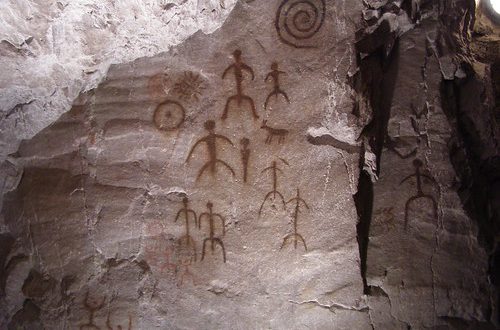Prehistoric cave painters in the Sahara Desert gave rise to ancient Egyptian civilisation, according to a German archaeological team. The paintings in a caves in Gilf Kebir, a vast sandstone plateau near the Egyptian-Libyan border, may be over 400 miles from the River Nile. But the team claims it was once a thriving community which later spread east to create Egypt’s famous cities and landmarks.
The plateau, a Martian landscape the size of Switzerland, is home to two famous caves, the ‘Cave of the Swimmers’ and the ‘Cave of the Beasts’ – Watch our amazing video of the caves and their paintings here. The former was discovered by Hungarian explorer Lszl Almsy and immortalised in the novel and Academy Award-winning movie The English Patient. But it is the latter which the team believe could unlock the secrets of how ancient Egypt began.
Rudolf Kuper, of Kln’s Heinrich Barth Institute, believes the Cave of the Beasts’ detail dates it back around 8,000 years. He claims its artists’ descendents would eventually emigrate to the Nile Valley to create pharaonic Egypt. “It is the most amazing cave … in North Africa and Egypt,” German expert Karin Kindermann tells AP. “You take a piece of the puzzle and see where it could fit. This is an important piece.”
The Eastern Sahara is the world’s largest warm dry desert. Modern Egyptians refer to it as the ‘Great Barrier’, known further afield as the Great Sand Sea. Yet at around 8,500 BC the region enjoyed seasonal rainfall and became a fertile savannah. By contrast the Nile Valley was an inhospitable swampland. Settlements sprang up across Gilf Kebir, but the rainfall slowly subsided. By 5,300 BC it has stopped altogether, and by 3,500 BC the settlements had disappeared completely. Ancient Egypt would appear along the now-bountiful Nile just a couple of hundred years later.
“After 3 – 4,000 years of savanna life environment in the Sahara, the desert returned and people were forced to move eastwards to the Nile Valley, contributing to the foundation of Egyptian civilisation, and southwards to the African continent,” says Kuper. “It was a movement, I think, step-by-step, because the desert didn’t rush in. The rains would withdraw, then return, and so on. But step by step it became more dry, and people moved toward the Nile Valley or toward the south.”
HD Video: Prehistoric Paintings in the Gilf Kebir
Read the transcript of this video here
Kuper and his team are conducting tests on the geological, botanical and archaeological evidence at the cave, and will compare it to other sites in the region. They have already discovered more drawings in the cave, which extend up to 80cm below the sand. “It seems that the paintings of the Cave of the Beasts pre-date the introduction of domesticated animals,” Kuper told AP. “That means they predate 6000 BC. That is what we dare to say.”
The Eastern Sahara has been home to some of archaeology’s strangest stories in recent years, including the theory that a necklace belonging to Tutankhamun came from outer space. A pair of Italian brothers also claimed to have discovered a lost Persian army who made a fateful detour through the area, yet the discovery has come under intense scrutiny. Kuper claims his team’s work is further enhancing the area’s profile as a key prehistoric site. “Now we have increasing evidence how rich the prehistoric culture in the Eastern Sahara was,” he says.




